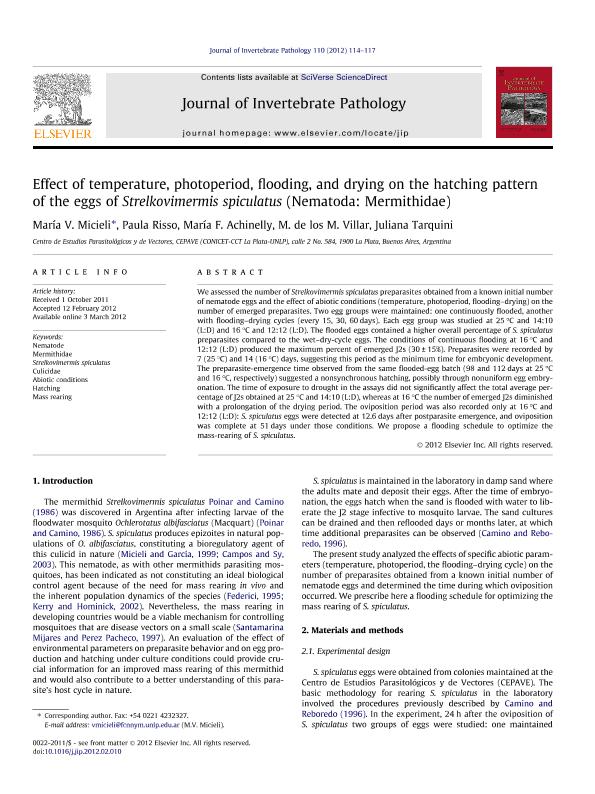Artículo
Effect of temperature, photoperiod, flooding, and drying on the hatching pattern of the eggs of Strelkovimermis spiculatus (Nematoda: Mermithidae)
Micieli, Maria Victoria ; Risso, Paula; Achinelly, Maria Fernanda
; Risso, Paula; Achinelly, Maria Fernanda ; Villar, Maria de los Milagros; Tarquini, Juliana
; Villar, Maria de los Milagros; Tarquini, Juliana
 ; Risso, Paula; Achinelly, Maria Fernanda
; Risso, Paula; Achinelly, Maria Fernanda ; Villar, Maria de los Milagros; Tarquini, Juliana
; Villar, Maria de los Milagros; Tarquini, Juliana
Fecha de publicación:
05/2012
Editorial:
Academic Press Inc Elsevier Science
Revista:
Journal of Invertebrate Pathology
ISSN:
0022-2011
Idioma:
Inglés
Tipo de recurso:
Artículo publicado
Clasificación temática:
Resumen
We assessed the number of . Strelkovimermis spiculatus preparasites obtained from a known initial number of nematode eggs and the effect of abiotic conditions (temperature, photoperiod, flooding-drying) on the number of emerged preparasites. Two egg groups were maintained: one continuously flooded, another with flooding-drying cycles (every 15, 30, 60. days). Each egg group was studied at 25. °C and 14:10 (L:D) and 16. °C and 12:12 (L:D). The flooded eggs contained a higher overall percentage of . S. spiculatus preparasites compared to the wet-dry-cycle eggs. The conditions of continuous flooding at 16. °C and 12:12 (L:D) produced the maximum percent of emerged J2s (30. ±. 15%). Preparasites were recorded by 7 (25. °C) and 14 (16. °C) days, suggesting this period as the minimum time for embryonic development. The preparasite-emergence time observed from the same flooded-egg batch (98 and 112. days at 25. °C and 16. °C, respectively) suggested a nonsynchronous hatching, possibly through nonuniform egg embryonation. The time of exposure to drought in the assays did not significantly affect the total average percentage of J2s obtained at 25. °C and 14:10 (L:D), whereas at 16. °C the number of emerged J2s diminished with a prolongation of the drying period. The oviposition period was also recorded only at 16. °C and 12:12 (L:D): . S. spiculatus eggs were detected at 12.6. days after postparasite emergence, and oviposition was complete at 51. days under those conditions. We propose a flooding schedule to optimize the mass-rearing of . S. spiculatus. © 2012 Elsevier Inc.
Archivos asociados
Licencia
Identificadores
Colecciones
Articulos(CEPAVE)
Articulos de CENTRO DE EST.PARASITOL.Y DE VECTORES (I)
Articulos de CENTRO DE EST.PARASITOL.Y DE VECTORES (I)
Citación
Micieli, Maria Victoria; Risso, Paula; Achinelly, Maria Fernanda; Villar, Maria de los Milagros; Tarquini, Juliana; Effect of temperature, photoperiod, flooding, and drying on the hatching pattern of the eggs of Strelkovimermis spiculatus (Nematoda: Mermithidae); Academic Press Inc Elsevier Science; Journal of Invertebrate Pathology; 110; 1; 5-2012; 114-117
Compartir
Altmétricas



